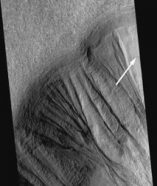Melting Snow on Mars
Melting blankets of snow may have carved out Martian gullies.
By Emily Sohn
The search for life on Mars often starts with a search for water. That’s because life as we know it can’t exist without the wet stuff.
And while scientists haven’t yet found any Martians crawling around—let alone flowing water on the planet—there have been some encouraging hints that life could exist on Mars. One of the most exciting signs came from a spacecraft in 2000 that revealed loads of gullies, which look like they were carved by water. Ever since then, space scientists have been trying to figure out where the water that carved the gullies could have come from.
 |
|
Martian gullies show remnant of a blanket of snow (arrow) that might have carved them. Image covers a region roughly 3 kilometers by 4.5 kilometers.
|
| Malin Space Science Systems/NASA/Nature |
Now, a scientist from Arizona thinks he has an explanation: snow. When Philip R. Christensen of Arizona State University in Tempe looked at pictures taken by the Mars Odyssey spacecraft, he saw light-colored blotches that looked like blankets of snow.
Christensen proposes that newly fallen snow mixes with Martian dust to create a thermal blanket, which absorbs the sun’s energy and melts layers of snow underneath. It would take about 5,000 years to carve out a gully that way, he estimates.
The orbiting spacecraft’s pictures didn’t turn up any alien creatures. But images and soil samples from future missions that land on the Red Planet might tell a different story. Mars today, says Bruce M. Jaksosky of the University of Colorado in Boulder, “appears to be right on the verge of being habitable by microbes.”—E. Sohn
Going Deeper:
Cowen, Ron. 2003. Martian gullies: Carved by melting snow? Science News 163(Feb. 22):116. Available at http://www.sciencenews.org/20030222/fob3.asp .







